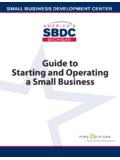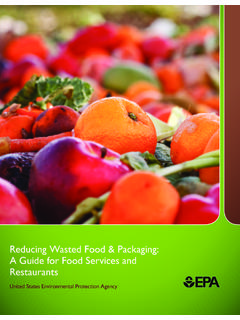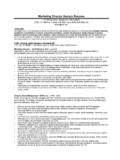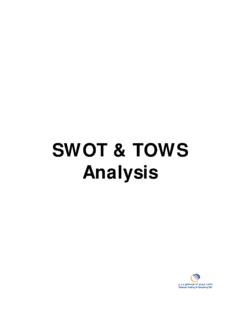Transcription of Grocery Store Start-Up and Operations Guide
1 Rural Grocery Store Start-Up and Operations GuideIllinois Institute for Rural AffairsWestern Illinois UniversityRural Grocery Store Start-Up and Operations GuidePublished by the Illinois Institute for Rural Affairs at Western Illinois University 518 Stipes Hall, 1 University Circle Western Illinois University Macomb, IL available on the Illinois Institute for Rural Affairs 2014iiTable of ContentsIntroduction and Purpose ..1 Description of Grocery Store ..1 Starting a Grocery Store ..1 Feasibility Study ..1 Market Analysis ..1 Market Survey ..3 Location and Site Selection ..3 Community ..3 Market Potential ..4 Facility.
2 4 Size and Layout ..4 Leasing versus Buying ..5 Leasing ..5 Leasing Checklist ..6 Phone and Utilities ..6 Equipment ..7 Used Equipment ..7 Point of Sale (POS) ..8 Office Equipment ..9 Security ..9 Inventory ..9 Start-Up Expenses ..10 Product Mix ..11 Layout ..11 Suppliers ..12 Margin and Markup ..12 Sales and Profits ..12 Forms of Business Ownership ..14 Sole Proprietorship ..14 General Partnership ..14 Limited Partnership ..14 Registering the Name of a Sole Proprietorship or General Partnership ..14 Limited Liability Regulations ..15 Corporation Regulations ..15 Bankers, Accountants, Attorneys ..16 Business Plan ..16 Operations .
3 17 Registrations, Licenses, and Taxes ..17 Insurance ..17 Advertising ..18 Hours ..19iiiService ..19 Vendors ..19 Sustaining a Rural Grocery Store - Managing Cash Flow ..19 Accrual vs Cash-based Accounting ..20 Estimating Expenses ..20 Estimating Income ..20 Adding Fresh to Your Existing Business ..21 Appendices ..23 Appendix A: Illinois Small Business Development Centers ..24 Appendix B: Feasibility Checklist ..27 Appendix C: Information References for Grocery stores ..32 Appendix D: Business Plan Checklist ..38 References ..411 Introduction and PurposeStarting and operating a small business can be both complicated and confusing for even an expe-rienced entrepreneur.
4 The purpose of this primer is to provide resources to facilitate the Start-Up process for a small Grocery and to give support to existing stores . There are numerous resources available many at no cost to entrepreneurs. These resources are listed throughout this docu-ment and in the appendices that follow. This Guide is not intended to take the place of profes-sional advice and all business owners (or potential owners) should work with qualified attorneys and/or accountants when seeking advice on technical matters. A great place for anyone interested in starting a small business in Illinois is one of the Small Business Development Centers.
5 These centers offer a wide range of services and advice, offer their services free, and are located through-out the state. A list of Small Business Development Centers is included in Appendix of Grocery StoreIn the past, small family-owned Grocery stores formed the basis of the supermarket industry. One family member minded the cash register, another stocked the shelves, and another unloaded the delivery truck. However, today many of the small independent Grocery stores in rural communities have either experienced financial difficulties or have been forced to factors contributed to the closures. First, many owner/operators of local stores have retired without a family member or another individual in place to continue the Store s Operations .
6 Second, communities experiencing a decline in population lost Grocery sales and the business was no longer viable. Third, residents in rural communities often commute to larger communities for employment and shop before returning home. Independents find it impossible to compete in price with large chains that have economies of scale. Fourth, independent grocers have also experienced competition from convenience/gasoline information contained in this booklet can be beneficial to those individuals currently in the Grocery business, those who are considering starting or investing in a Grocery , or a community wishing to attract or retain a Grocery a Grocery StoreFeasibility StudyBefore starting any new business, it is necessary to know if it is feasible to invest both time and money into the venture.
7 Unfortunately, not all good ideas make great businesses, or even make money. Determining the feasibility of starting a business may be one of the most crucial tasks fac-ing entrepreneurs. A feasibility checklist should be used to determine if an idea represents a real business opportunity to expand or create a new business. The checklist in Appendix B includes both personal and market AnalysisOnce the feasibility checklist is successfully completed, entrepreneurs should conduct a market analysis. A market analysis consists of conducting a market survey and gathering information about potential locations and the community.
8 This will allow the entrepreneur to assess the mar-ket potential of the proposed Store and select a site. Usually small independent Grocery stores are patronized by those who do not travel outside the community regularly or customers who are in a hurry. These customers are often willing to pay a few cents more for an item rather than drive 2 Jackson Street Market, Macomb Illinois A Model for Small TownTerry Sparrow has been the owner/operator of the Jackson Street Market in the college town of Macomb, Illinois, for the past three years. Despite its size of only 7,800 sq. ft., it is a full service gro-cery Store with produce, frozen food and a meat department doing in-house butchering.
9 The Jackson Street Market, located on the west side of town, faces all of the challenges common to most small Grocery stores . Macomb is also served by Super Walmart Center and a Hy-Vee Grocery Store , both located on the east side of town close to most of the retail development. Near the center of town is a large County Market Grocery Store that benefits from having residential neighborhoods on three sides. As an independent grocer, Mr. Sparrow does not have the tremendous resources that these corporations have. So how has he managed to stay in business for the past three years? According to Mr. Sparrow, his strategy goes back to his original business plan: We have identified five niches that will help make this Store successful.
10 1) We will offer ..the finest cuts (of meat) that will bring repeat customers in just for the meat selection. 2) We intend to stock the freshest produce available; organic selections will also be available. 3) We intend to have a full line alcohol selection that can operate with the Store or on its own. 4) We can offer the personal touch and service that the larger stores cannot. 5) Our location will offer a convenient alternative to driving across town for weekly shopping, or for fill-in shopping throughout the compete with the larger stores , the Jackson Street Market works to bring added value and en-hanced service to his customers.






